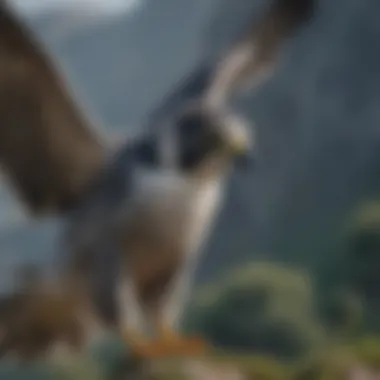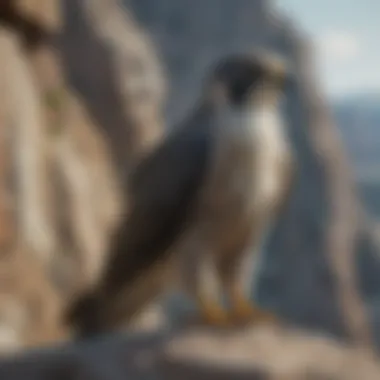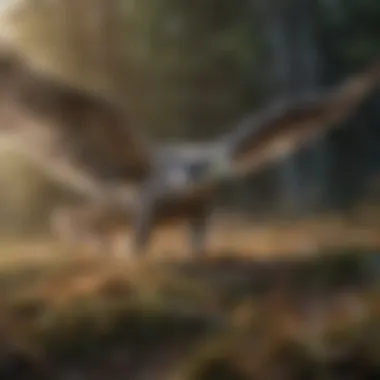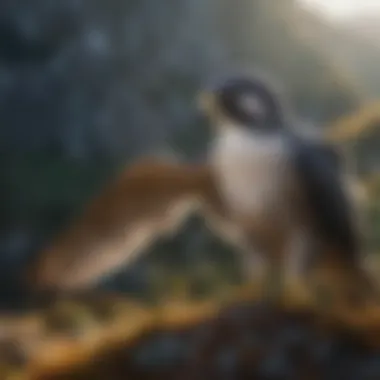Discover the Intriguing World of Peregrine Falcons: Unveiling Their Remarkable Attributes


Nature Topic Overview
Peregrine Falcons stand out as a true marvel of the avian world, captivating nature enthusiasts with their astounding capabilities. From their impressive speed to unique hunting techniques, these majestic birds of prey continue to intrigue researchers and observers alike. It is truly mesmerizing to delve into the world of Peregrine Falcons and unravel the mysteries behind their exquisite features and behaviors.
Introduction to Peregrine Falcons
Peregrine Falcons, scientifically known as Falco peregrinus, are a subject of immense fascination and study within the realm of ornithology. These magnificent birds of prey possess a plethora of unique traits and behaviors that set them apart from other avian species. Through a detailed exploration of Peregrine Falcons, this article aims to unravel the mysteries surrounding these aerial predators, shedding light on their physical attributes, hunting techniques, nesting habits, and conservation challenges.
Overview of Peregrine Falcons
Peregrine Falcons: A Brief Introduction
The Peregrine Falcon, renowned for its breathtaking speed and agility, stands tall as one of the swiftest creatures in the animal kingdom. With a diving velocity reaching over 240 miles per hour during hunting stoops, these birds showcase unparalleled precision and power. Their keen eyesight and compact build contribute to their exceptional aerodynamic prowess, making them supreme hunters in the avian world.
Peregrine Falcon Taxonomy and Classification
Delving into the taxonomy and classification of Peregrine Falcons unveils a complex genetic lineage that showcases their evolutionary adaptations. Belonging to the family Falconidae, these raptors exhibit distinctive characteristics that have propelled them to the apex of avian predators. Their taxonomic classification provides researchers with valuable insights into their phylogenetic relationships and ecological roles, enriching our understanding of these remarkable birds.
Physical Characteristics
Peregrine Falcon Size and Weight
The size and weight of Peregrine Falcons play a crucial role in their hunting strategies and overall survival. With a wingspan ranging from 3 to 4 feet and a weight of approximately 2 to 3 pounds, these birds strike a balance between agility and power. Their muscular build and aerodynamic design enable them to maneuver swiftly through the skies, making them formidable hunters capable of outmaneuvering their prey.


Peregrine Falcon Plumage and Coloration
The plumage and coloration of Peregrine Falcons serve as a camouflage mechanism essential for both hunting and nesting. Their iconic blue-gray back, barred underparts, and distinct facial markings not only enhance their visual appeal but also aid in blending seamlessly with their surroundings. This adaptive coloration confers a survival advantage by providing concealment during both aerial pursuits and nesting activities.
Habitat and Distribution
Peregrine Falcon Habitat Preferences
A deep dive into the habitat preferences of Peregrine Falcons reveals their affinity for rugged terrains and tall structures resembling natural cliffs. High cliffs, skyscrapers, and rocky outcrops mimic their natural nesting sites, offering ideal vantage points for hunting and raising their young. These specialized habitat choices showcase the adaptability of Peregrine Falcons to urban environments, where they carve out niches amidst human infrastructure.
Global Distribution of Peregrine Falcons
The global distribution of Peregrine Falcons spans across six continents, emphasizing their ubiquitous presence in varied landscapes. From the Arctic tundra to tropical rainforests, these birds display a remarkable ability to thrive in diverse ecosystems. Their adaptability to different climatic conditions and geographical regions showcases their resilience and evolutionary success on a global scale.
Unique Adaptations and Behaviors
The section of Unique Adaptations and Behaviors in this article provides a detailed insight into the distinctive features and behaviors that set Peregrine Falcons apart in the avian world. By exploring specific elements such as their remarkable speed, intricate hunting techniques, and adaptable nature, readers will uncover the fascinating aspects of these birds' survival strategies and evolutionary adaptations. Understanding the nuances of Peregrine Falcons' behaviors not only offers a glimpse into their daily lives but also sheds light on their crucial role in maintaining ecological balance.
Flight Patterns and Speed
Peregrine Falcon Soaring Abilities
Delving into the Peregrine Falcon's Soaring Abilities, one cannot overlook the sheer majesty of these birds in flight. Their unique ability to soar at great heights with remarkable agility and precision is a testament to their evolutionary prowess. The key characteristic of Peregrine Falcon Soaring Abilities lies in their unmatched aerodynamic design, allowing them to navigate vast distances with minimal effort. This feature is instrumental in their hunting expeditions, enabling them to spot prey from great heights and execute swift dives to capture their target with unparalleled speed and accuracy.


The Fastest Animal on Earth: Peregrine Falcon Speed
When discussing The Fastest Animal on Earth: Peregrine Falcon Speed, it becomes apparent why these birds hold this title with merit. Peregrine Falcons boast breathtaking speed capabilities, reaching velocities that surpass most other creatures in the animal kingdom. This exceptional speed is a crucial asset in their hunting escapades, giving them a strategic advantage when targeting fast-moving prey. The unique feature of Peregrine Falcon Speed lies in their ability to reach astonishing speeds during high-speed dives, known as stoops, plunging towards their prey with astonishing velocity and precision.
Hunting Techniques
Stoop and Strike: Peregrine Falcon Hunting Strategy
The hunting technique known as Stoop and Strike epitomizes the Peregrine Falcons' predatory skills. This strategy involves the bird swiftly diving from great heights, using gravity to accelerate towards its target before striking with lethal accuracy. The key characteristic of this hunting technique lies in its effectiveness in catching agile prey such as birds in mid-flight. The unique feature of Stoop and Strike lies in the Peregrine Falcon's mastery of speed and agility, making them formidable hunters in the skies.
High-Rise Hunters: Urban Peregrine Falcons
Urban Peregrine Falcons exhibit a distinct hunting strategy tailored to their cityscape habitats, known as High-Rise Hunting. These birds have adapted to urban environments, utilizing tall buildings as vantage points to spot prey and launch strategic attacks. The key characteristic of High-Rise Hunters lies in their ability to thrive in metropolitan settings by preying on pigeons and other city-dwelling birds. The unique feature of Urban Peregrine Falcons is their resilience in adapting to human-altered landscapes, showcasing their remarkable versatility in the face of urbanization.
Reproductive Biology and Lifecycle
Reproductive biology and lifecycle play a vital role in understanding the dynamics of Peregrine Falcons. The process of reproduction is essential for the continuation of species, ensuring genetic diversity and population sustainability. In the case of Peregrine Falcons, their nesting behaviors, incubation periods, and fledging stages are crucial aspects of their lifecycle. Observing and documenting these processes provide researchers with valuable insights into the species' habits and survival strategies. The lifecycle of Peregrine Falcons offers a fascinating glimpse into the wonders of nature and the intricate balance of life.
Nesting Behavior
Peregrine Falcon Nest Construction
The construction of Peregrine Falcon nests is a meticulous process that begins with selecting a suitable location. Peregrine Falcons prefer high cliffs or tall structures for nesting, providing them with a strategic vantage point for hunting and protecting their young. Their nests are composed of sticks, twigs, and grasses intricately woven together to form a sturdy platform. This construction not only offers stability and protection but also camouflages the nest, blending seamlessly into the natural surroundings. The unique feature of Peregrine Falcon nest construction lies in its durability and resilience, withstanding harsh weather conditions and potential disturbances.


Parental Care and Incubation
Parental care and incubation are vital components of Peregrine Falcon nesting behavior. Once the eggs are laid, both male and female Falcons take turns incubating the eggs, demonstrating exceptional teamwork and dedication. This shared responsibility ensures a consistent temperature for optimal egg development. Parental care extends beyond incubation to feeding and protecting the hatchlings. Peregrine Falcons exhibit a high level of attentiveness and affection towards their young, fostering their growth and survival. The unique feature of Peregrine Falcon parental care is their ability to adapt to external threats while nurturing their offspring, showcasing their resilience and adaptability.
Fledging and Juvenile Stage
Young Peregrine Falcons: Learning to Fly
The fledging stage marks a significant milestone in the lives of young Peregrine Falcons. Learning to fly is a crucial skill that requires practice, guidance, and courage. Young Falcons are encouraged by their parents to exercise their wings, gradually building strength and coordination. The process of learning to fly not only enhances their physical abilities but also prepares them for independence. Peregrine Falcons' unique feature in this stage is their innate agility and speed, traits that are honed through continued practice and exploration.
Maturation and Independence
As Peregrine Falcons mature, they undergo a process of independence from their parents. This stage is marked by their ability to hunt and navigate the environment on their own. Maturation involves developing advanced hunting techniques, honing survival instincts, and establishing territories. The key characteristic of maturation in Peregrine Falcons is their adaptation to diverse habitats and hunting grounds. This flexibility enables them to thrive in varying landscapes, ensuring their continued presence and success in the wild.
Conservation Challenges and Success Stories
Conservation Challenges and Success Stories regarding Peregrine Falcons are of paramount importance in understanding the delicate balance between human activity and wildlife preservation. The historical decline of Peregrine Falcons due to various factors necessitated comprehensive recovery efforts to ensure the survival of this remarkable species. In this section, we will delve into the critical aspects of Peregrine Falcon conservation, shedding light on both the challenges faced and the inspiring success stories that have emerged over the years.
Historical Decline and Recovery Efforts
The Impact of Pesticides on Peregrine Falcon Populations stands out as a pivotal factor in the historical decline of these magnificent birds. The detrimental effects of pesticides such as DDT on Peregrine Falcons' reproductive success and overall population health cannot be overstated. Despite the grim situation, concerted efforts were made to curb the use of these harmful chemicals and initiate recovery programs to boost falcon numbers.
Conservation Measures and Population Rebound have played a crucial role in reversing the decline of Peregrine Falcons. Implementing captive breeding programs, habitat restoration initiatives, and strict regulations on pesticide use have contributed significantly to the increase in Peregrine Falcon populations across different regions. The resilience and adaptability of these birds, coupled with conservation efforts, have led to heartening recoveries in various parts of their natural habitats.
Current Threats and Future Outlook
Urbanization and Habitat Loss pose significant challenges to Peregrine Falcons as human activities encroach upon their traditional nesting sites and foraging grounds. The rapid expansion of urban areas often leads to habitat fragmentation, disrupting the falcons' ability to find suitable locations for nesting and hunting. Finding a harmonious coexistence between urban development and wildlife conservation remains a pressing issue for ensuring the continued survival of Peregrine Falcons.
Climate Change Impacts on Peregrine Falcons present a complex web of challenges related to shifting weather patterns, altered prey availability, and habitat transformations. The increasing variability in temperatures and precipitation patterns can have profound effects on the falcons' breeding success and migratory behaviors. Understanding the intricate ways in which climate change impacts Peregrine Falcons is crucial for developing proactive conservation strategies to mitigate these threats and secure a sustainable future for these magnificent raptors.







